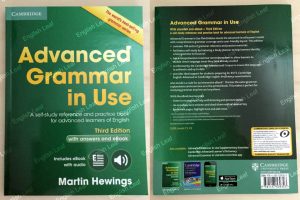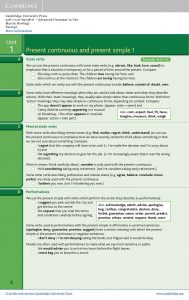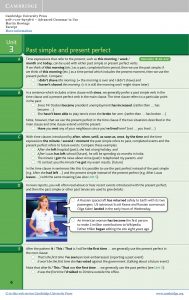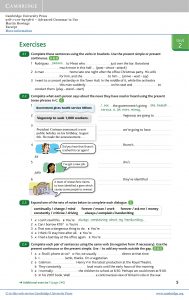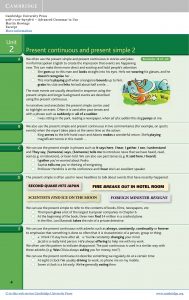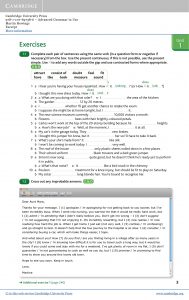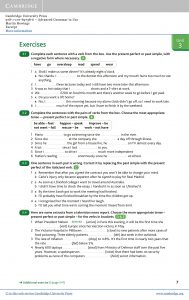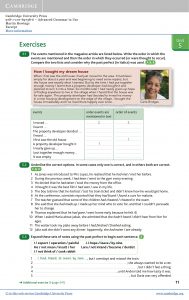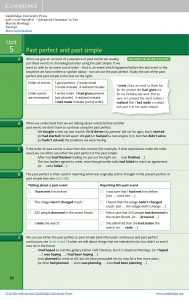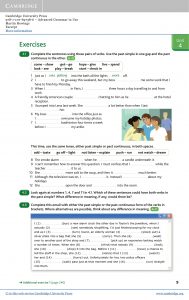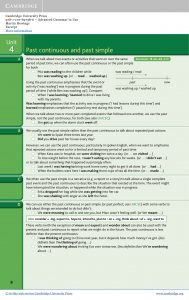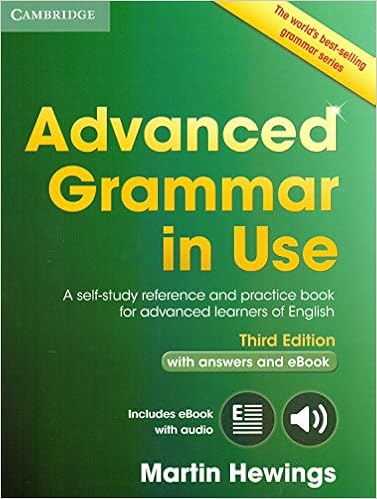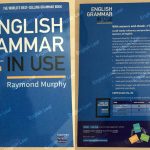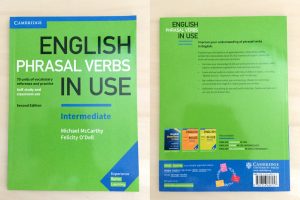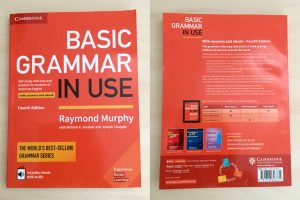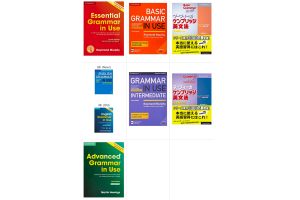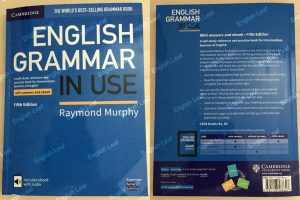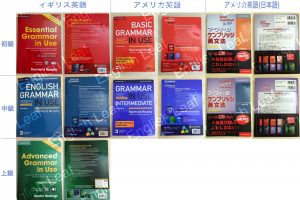文法書のバイブル! English Grammar in Useシリーズの種類と選び方
も確認する。
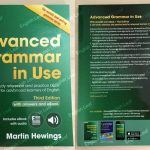
Contents
Thanks
To the student
To the teacher
Tenses
1 Present continuous and present simple 1
2 Present continuous and present simple 2
3 Past simple and present perfect
4 Past continuous and past simple
5 Past perfect and past simple
6 Present perfect continuous and present perfect
7 Past perfect continuous, past perfect and past continuous
8 Present and past time: review
The future
9 Will and be going to
10 Present simple and present continuous for the future
11 Future continuous and future perfect (continuous)
12 Be to + infinitive; be about to + infinitive
13 Other ways of talking about the future
14 The future seen from the past
Modals and semi-modals
15 Can, could, be able to and be allowed to
16 Will, would and used to
17 May and might
18 Must and have (got) to
19 Need(n’t), don’t need to and don’t have to
20 Should, ought to and had better
Linking verbs, passives, questions
21 Linking verbs: be, appear, seem; become, get, etc.
22 Forming passive sentences 1
23 Forming passive sentences 2: verb + -ing or to-infinitive
24 Using passives
25 Reporting with passives; It is said that …
26 Wh-questions with who, whom, which, how and whose
27 Negative questions; echo questions; questions with that-clauses
Verb complementation: what follows verbs
28 Verbs, objects and complements
29 Verb + two objects
30 Verb + -ing forms and infinitives 1
31 Verb + -ing forms and infinitives 2
If you are not sure which units you need to study, use the Study planner on page 210.
Reporting
32 Reporting people’s words and thoughts
33 Reporting statements that clauses
34 Verb + wh-clause
35 Tense choice in reporting
36 Reporting offers, suggestions, orders, intentions, etc.
37 Modal verbs in reporting
38 Reporting what people say using nouns and adjectives
39 Should in that clauses; the present subjunctive
Nouns
40 Agreement between subject and verb 1
41 Agreement between subject and verb 2
42 Agreement between subject and verb 3
43 Compound nouns and noun phrases
Articles, determiners and quantifiers
44 A/an and one
45 A/an, the and zero article 1
46 A/an, the and zero article 2
47 A/an, the and zero article 3
48 Some and any
49 No, none (of) and not any
50 Much (of), many (of), a lot of, lots (of), etc.
51 All (of), whole, every, each
52 Few, little, less, fewer
Relative clauses and other types of clause
53 Relative pronouns
54 Other relative words: whose, when, whereby, etc.
55 Prepositions in relative clauses
56 Other ways of adding information to noun phrases 1: additional noun phrases, etc.
57 Other ways of adding information to noun phrases 2: prepositional phrases, etc.
58 Participle clauses with adverbial meaning 1
59 Participle clauses with adverbial meaning 2
Pronouns, substitution and leaving out words
60 Reflexive pronouns: herself, himself, themselves, etc.
61 One and ones
62 So and not as substitutes for clauses, etc.
63 Do so; such
64 More on leaving out words after auxiliary verbs
65 Leaving out to-infinitives
if you are not sure which units you need to study, use the Study planner on page 210.
Adjectives and adverbs
66 Position of adjectives
67 Gradable and non-gradable adjectives 1
68 Gradable and non-gradable adjectives 2
69 Participle adjectives and compound adjectives
70 Adjectives + to-infinitive, -ing, that-clause, wh-clause
71 Adjectives and adverbs
72 Adjectives and adverbs: comparative and superlative forms
73 Comparative phrases and clauses
74 Position of adverbs 1
75 Position of adverbs 2
76 Adverbs of place, direction, indefinite frequency, and time
77 Degree adverbs and focus adverbs
78 Comment adverbs and viewpoint adverbs
Adverbial clauses and conjunctions
79 Adverbial clauses of time
80 Giving reasons: as, because, etc.; for and with
81 Purposes and results: in order to, so as to, etc.
82 Contrasts: although and though; even though / if; while, whilst and whereas
83 If 1
84 If 2
85 If I were you …, imagine he were to win
86 If… not and unless; if and whether; etc.
87 Connecting ideas in a sentence and between sentences
Prepositions
88 Prepositions of position and movement
89 Between and among
90 Prepositions of time
91 Talking about exceptions
92 Prepositions after verbs
93 Prepositions after nouns
94 Two- and three-word verbs: word order
Organising information
95 There is, there was, etc.
96 It 1
97 It 2
98 Focusing: it-clauses and what-clauses
99 Inversion 1
100 Inversion 2
If you are not sure which units you need to study, use the Study planner on page 210.
Appendix 1 Irregular verbs
Appendix 2 Passive verb forms
Glossary
Study planner
Grammar reminder
Additional exercises
Key to Exercises
Key to Study planner
Key to Additional exercises
Index of grammatical items Index of lexical items
If you are not sure which units you need to study, use the Study planner on page 210.
Thanks
I would like to thank all those who worked with me on the first two editions of Advanced Grammar in Use, in particular Jeanne McCarten and Alison Sharpe for their encouragement. Thanks also to my former colleagues and students in the English for International Students Unit at the University of Birmingham for their help and interest.
For this third edition I am grateful to Colin McIntosh, Nora McDonald, Annabel Marriott, Sabina Sahni, Kevin Doherty, Andy George, Claire Cole and Janet Weller. Claire and Janet in particular have given me tremendous support in preparing the book.
Thanks to Sophie Joyce, Sandy Nichols, Katie Mac, Ian Mitchell and David Whamond for the illustrations and to Kamae Design for their work on the finished product. I would also like to thank Cambridge University Press for allowing me access to the Cambridge International Corpus.
Many students and teachers sent me comments on the 2nd edition, and these have been very helpful in writing this new edition. Thank you all for taking the trouble to contact me.
Finally, my thanks, as ever, to Suzanne, David and Ann.
The authors and publishers acknowledge the following sources of photographs and are grateful for the permissions granted.
p. 6: WithGod/Shutterstock; p. 11: Comstock Images/Thinkstock; p. 17: Thinkstock; p. 33: Image Source/Glowimages; p. 39: Thinkstock; p. 109: Thinkstock; p. 114: Bildagentur RM/Glowimages.
To the student
Who the book is for
Advanced Grammar in Use is for advanced students of English. It was written mainly as a self-study book, but might also be used in class with a teacher.
How the book is organised
There are 100 units in the book, each looking at a particular area of grammar. Some sections within each unit focus on the particular use of a grammatical pattern, such as will be + -ing (as in will be travelling); others explore grammatical contrasts, such as whether to use would or used to in reporting past events, or when we use except or except for.
The 100 units are grouped under a number of headings such as Tenses and The future, and you can find details of this in the Contents. Each unit consists of two pages. On the left-hand page are explanations and examples; on the right-hand page are practice exercises. The letters next to each exercise show you which section(s) of the left-hand page you need to understand to do that exercise.
At the back of the book you will find a number of further sections.
Appendices (pages 202 and 204) Two appendices provide further information about irregular
verbs and passive verb forms.
Glossary (page 205) Although terms to describe grammar have been kept to a minimum, some have been included, and you can find explanations of these terms in the Glossary.
Study planner (page 210) You can use the Study planner to help you decide which units you should study, or which parts of the Grammar reminder you should read first.
Grammar reminder (page 222) This presents examples and explanations of areas of grammar that you are likely to have studied already at earlier stages of learning English. References on the lefthand page of each unit point you to the sections of the Grammar reminder relevant to that unit. Read these sections to refresh your understanding before you start work on the more advanced grammar points in the unit.
Additional exercises (page 240) If you want further practice of grammar points, follow the references at the bottom of the right-hand page of a unit. These will tell you which of the Additional exercises to do next.
Keys (pages 251, 277 and 278) You can check your answers to the practice exercises, Study planner and Additional exercises in the keys. You will also find comments on some of the answers.
Indexes (pages 281 and 287) Use the Indexes to help you find the grammar or vocabulary you need.
How to use the book
It is not necessary to work through the units in order. If you know which grammar points you have difficulty with, go straight to the units that deal with them, using the Contents or Indexes to help you find the relevant unit. When you have found a unit to study, read through any related material in the Grammar reminder before you begin.
You can use the units in a number of ways. You might study the explanations and examples first, do the exercises on the opposite page, check your answers in the key to Exercises, and then look again at the explanations if you made any mistakes. If you just want to practise an area of grammar you think you already know, you could do the exercises first and then study the explanations for any you got wrong. You might of course simply use the book as a reference book without doing the exercises.
Corpus information
A corpus is a large collection of texts stored on a computer. In writing Advanced Grammar in Use we have worked with the Cambridge International Corpus (CIC), a multi-million word collection of real speech and writing, and the Cambridge Learner Corpus, a collection of exam answers written by students. From these corpora we can learn more about language in use, and about the common errors made by learners. Using this information, we can be sure that the grammar explanations and examples in the book reflect real language, and we can focus on problem areas for learners. We have also used the CIC to produce word boxes, listing the most common words found in particular grammar patterns.
To the teacher
Advanced Grammar in Use was written as a self-study grammar book but teachers might also find it useful for supplementing or supporting their classroom teaching. The book will probably be most useful for advanced level students for reference and practice.
No attempt has been made to order the units according to level of difficulty. Instead, you should select units as they are relevant to the syllabus that you are following with your students, or as particular difficulties arise, rather than working through from beginning to end. Alternatively, you could ask students to do the multiple-choice test in the Study planner (page 210) and focus on units that deal with areas of grammar where students are least successful.
Don’t forget to point students to the Grammar reminder (page 222). This is a reference-only section which presents basic knowledge on a number of areas of grammar. It will be useful for students to read through a section before moving on to the more advanced material in the units. At the beginning of each section of the Grammar reminder you will find information about the unit(s) it relates to.
There are many ways in which you can use the book with a class. You might, for example, present the explanations on the left-hand page of a unit, and use the exercises for classroom practice. Alternatively, you might want to begin with the exercises and refer to the left-hand page only when students are having problems. You could also set particular units or groups of units (such as those on Articles or Nouns) for self-study if individual students are having difficulties.
Another possibility might be to develop your own classroom-based activities around the explanations on the left-hand page of a unit, and then set the exercises as consolidation material for self-study. When students need further practice of grammar points from a number of different units, refer them to the Additional exercises (page 240). References at the bottom of the right-hand pages show where the relevant Additional exercises can be found.
An edition of Advanced Grammar in Use without the answers is also available, and some teachers might prefer to use it with their students.The third edition of Advanced Grammar in Use has the same comprehensive grammar coverage as previous editions, but many of its exercises have been revised and its layout made more user-friendly.
Interactive eBook
You can buy this book with or without an eBook. The eBook has the same grammar explanations and exercises as the book.
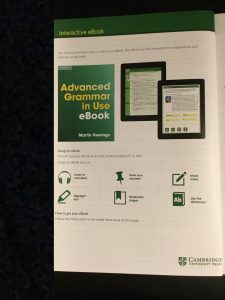
Using the eBook
You can use your eBook on an iPad, Android tablet, PC or Mac.
Using the eBook you can:
Listen to examples
Save your answers
Make notes
Highlight text
Bookmark pages
Use the dictionary
How to get your eBook
Follow the instructions in the inside front cover of this book.
サンプルページAdvanced Grammar in Use
文法書のバイブル! English Grammar in Useシリーズの種類と選び方
も確認する。
